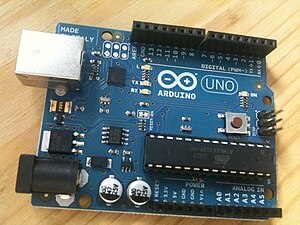At 7 pm, on Monday August 5th, 2013, I’ll be at Princeton Public Library, I’m going to be giving an introductory overview of open source hardware, the Make movement, and the ideology of openness. In particular, I’ll be talking about Arduino, Raspberry Pi, and related hardware projects.
(post event note: Thanks to everyone who came out, and here is the link to the presentation)

Arduino is an open-source electronics prototyping platform based on flexible, easy-to-use hardware and software. In other words you can build all kinds of cool shit with it. And yes, you can program it with Python 🙂 (Photo credit: Wikipedia)
The Arduino is an electronics learning platform. The instructions for how to make one from scratch are freely available, which is why it is considered open source hardware, though many people find it far easier and supportive to the platform to just buy one. You can get them at your local Radio Shack. Once you have it connected to a computer, you can begin to program it or run programs that others have made for it, called sketches. The key idea with Arduino is that you program it to accept input from sensors or scripts, and to produce output in the form of light, sound, and other signals. With this basic idea, you can use the Arduino to solve little problems like knowing when the Dryer has stopped, feeding your animals reasonably while you are away, or making sophisticated environment based games.
The Raspberry Pi is perhaps a simpler idea for the uninitiated: a computer capable of doing most anything your laptop, desktop, tablet or phone can do (given the monitor, keyboard and mouse) available for $25-$35 dollars, depending on model. Because of the incredibly low price but relatively strong computing power, you can use the Pi to do all kinds of interesting things that you would not consider doing with your desktop or laptop machine. Running home automation, media servers, dedicated graphics workstations, an email terminal, a streaming media interface for your TV, and much more.
Related articles
This content is published under the Attribution 3.0 Unported license.


Pingback: Show Notes for Technology and the Arts – Episode 60 | T&A: Technology and the Arts